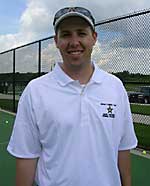|
TennisOne Lessons Seven Doubles Principles for USTA League Players Neutralize First, Then Finish By David Brouwer Many players, whether singles or doubles players, try to hit what I call the “tv” shot so many times in a match without really being set up to do so. Rather than developing a point or thinking ahead to a pattern or tactic, they try to finish right off the first strike of the ball. Although doubles is a fast paced game and the points usually don't last very long, there is a way to play higher percentage shots in order to set up finishing shots. At our clubs, we call these shots “neutralizers.”
Some examples of neutralizers are:
Each of these shots can be used as a neutralizer to give your team a set up to put away the very next ball. Following are some scenarios for each of the above neutralizers and also some examples of how to use them. Return of Serve
In today's power game, there is a tendency for many club players to blast off on every ball, including the return of serve. However, the harder the return is hit, the quicker the next ball comes back at the returning team. This puts the returner at a disadvantage, especially if they're following their return in, because now they're hitting a volley from their shoestrings. A better play would be to take some pace off the ball by adding some topspin or slice. Try to “dump” the return right around the service line. This neutralizes the server in two ways: If they are closing in for a volley, they will have to volley the ball up, therefore creating a secondary poach for the returner's partner. If they are serving and staying back, the short return will force them to move forward, and also create the possibility of a floating ball across the center. So the return at the feet or at the service line neutralizes the serving team and allows the returning team the better opportunity to receive a weak ball for their second shot. The Serve
Again, most players today want to blast off on their serve. This is okay if the player has excellent percentage and gets a lot of aces or service winners. However, for the average USTA league player, using the serve as a set up is much more realistic. Specifically, using the serve into the body can create a set up for the server's partner to put away. Even if the returner gets the ball back crosscourt, it's usually a weaker return and the server can hit an offensive shot on the next ball. The defensive lob So many times, the “tv” shot gets played when a team has to switch and recover a tough lob. By “tv” shot I mean the between the legs shot, the over the shoulder overhead, or the twirling groundstroke drive that you pray clears the net. Rather than trying to hit these nearly impossible shots, why not get your trusty volley grip, open the face of the racquet, and hoist a high floater over the backhand side of one of your opponents? This shot gives you plenty of time to get back on balance as a team and, if played well, neutralizes your opponents into a defensive position. The short angle slice
There's no question about it, groundstrokes are fun to hit these days. Even in pro doubles matches, we see some players staying on the baseline and just ripping topspin drives at the feet of their opponents. Another option, however, is the short angle slice from the backcourt. Let's say that the returner gets pinned back on the baseline from a good serve and the server then makes a good deep volley back to them. A great neutralizer, and one that many players don't expect, is a short angle crosscourt slice. You have to be careful not to float it, but if you hit it sharp enough and with enough backspin, it's a wicked neutralizer and presents a very awkward volley for the opponent. The first volley
Many times, when league players get a high first volley off their serve or return, they look to finish the point right away. However, a good neutralizer is to be patient and take that ball right back cross court to pin the opponent back for one more ball. We all know that pinning one player back to the baseline eventually opens up some space on the court to hit a winner to. Why not take that mid court approach or mid court volley back to the baseliner one more time to neutralize their ability to play an aggressive shot. All of these ideas simply add up to higher percentage tennis. As one pro said to me the other day, “whether you're playing Roger Federer or a 3.5 club league match, the goal is the same: hit it over the net one more time than the other guy.” This is very true in doubles as well. If you can neutralize first, and then use the setup to finish the point, you'll win more matches! Your comments are welcome. Let us know what you think about David Brouwer's article by emailing us here at TennisOne.
David was voted the USPTA Michigan Professional of the year in 2002 and has won two USPTA Outstanding Education awards. David has been a speaker at the USPTA Midwest and National conventions and is the Director of the West Michigan Tennis Academy. David coaches USTA league players of all levels and finds great joy in coaching strategy and tactics to build smarter tennis players. |

 David Brouwer, USPTA is the Director of Tennis for three major health clubs in Grand Rapids , MI.
David Brouwer, USPTA is the Director of Tennis for three major health clubs in Grand Rapids , MI.